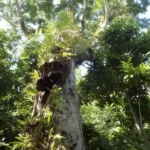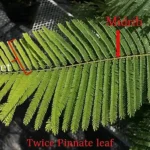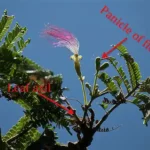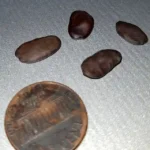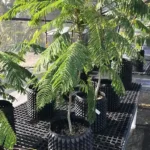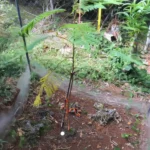Guam Tree: Håyun Lågu
Table of Contents
Share This
Serianthes nelsonii is a tree species that is endemic to the Mariana Islands of Guam and Rota. Each island has its own unique local name for this plant. On the island of Guam, it is called håyun lågu, meaning “northern tree” or “foreign tree” (Figure 1), and in Rota, it is called trongkon guåfi or trongkon fi’a, meaning “fire tree”.
In 1919, western Pacific botanist Elmer D. Merrill named S. nelsonii after Peter Nelson of the Guam Department of Agriculture, who originally brought the species to the attention of botanists. It is the tallest tree in the Mariana Islands, with the highest recorded tree reaching 40 meters. Since its discovery, S. nelsonii has been listed as a rare tree species because less than 150 individual trees have been documented.
Scientists recorded the known uses of S. nelsonii in 1991 as shade and timber. A possible reason for the lack of other cultural uses may be that the tree was never common enough for people to use often, or it was so heavily used that it was over-harvested early in the history of the islands and has never recovered. It is a beautiful tree with striking flowers and a large presence in the native forests, similar to the value of the giant redwoods in California.
Last tree standing on Guam
Today, there is only one naturally occurring S. nelsonii in Guam, located in Northwest Field, Andersen Air Force Base. In 1987, S. nelsonii was federally listed as endangered by the US Fish and Wildlife Service.
Håyun lågu belongs to the legume, or pea, family (Fabaceae, subfamily Mimosoideae) and typically towers over the forest canopy. S. nelsonii was classified by Dr. Lynn Raulerson, former University of Guam Biology professor, as “a large tree that can reach a height of 36 meters and a diameter of 2 meters. Leaves are a dark glossy green color, twice pinnately compound, containing 10-20 pairs of pinnae each, and with 20-22 pairs of leaflets” (Figure 2).
The midrib of the leaf is hairy and rust- colored. The flowers grow in panicles from leaf axils, resembling a brush, due to their long pinkish filaments coming out of the center (Figure 3). Its fruits are 7 to 12 cm long and 2 to 2.5 cm wide, hairy, brownish pods that have a slight constriction between each of 1 to 7 seed(s). Seeds are shiny, dark brown, smooth, flat, and 10 x 8 mm in size (Figure 4).
More on Rota
Today, there are less than 50 wild individual trees in Rota and only one remains in Guam. All naturally occurring S. nelsonii trees in Rota and Guam are found on limestone-derived soils. Håyun lågu is found with other common limestone plant species such as Guamia mariannae, “paipai”; Ochrosia oppositifolia (formerly called Neisosperma), “fagot”; Macaranga thompsonii, “pengua”; Ochrosia mariannensis, “langiti”; Premna obtusifolia, “ahgao”; Psychotria mariana, “aplokhating”; and Pisonia grandis, “umumu”.
In Rota, these trees can be found growing on or near limestone cliffs from 150 to 420 meters in elevation, while trees in Guam grow from 120 to 175 meters elevation. The lone wild tree in Guam, in Northwest Field Andersen Air Force Base, is at an elevation of 150 meters. The tree was approximately 36 meters tall before a typhoon broke the main trunk. Today it is approximately 10 meters tall, but still growing.
A håyun lågu was observed growing at the base of Mt. Tenjo and Mt. Alutom, where soil is primarily of the savanna grassland type. However, this tree died of natural causes by the time of the initial listing of S. nelsonii.
The lone standing, mature tree on Guam is threatened by insects, ungulates, pathogens, typhoons, decreased number of pollinators and seed dispersers, and habitat loss due to human activity. Habitat loss is a critical issue for S. nelsonii because there are very few individuals remaining in the Marianas, and without its habitat conserving remaining trees and managing possible reintroductions is very challenging.
Pests are also a problem. Mealybugs, butterfly larvae, katydids, and seed weevils attack different parts of the plant. Mealybugs infest the leaves, roots, and shoot tips, and suck the juices out of the plant, leaving it in a weakened state.
The butterfly Eurema blanda lays its eggs on S. nelsonii leaves and the larva eat the leaves. Katydids lay their eggs in the stems of seedlings and small branches of the mature tree, causing structural damage to that area of the plant. Seed weevils burrow into the seedpod and damage the seeds, preventing them from being able to germinate. Pigs and deer disturb and destroy regenerating seedlings. The mature tree has large conks from a fungus called Ganoderma sp. that rots the wood.
Recovery plan in place
Measures are being taken to recover the species. In 1994, The US Fish and Wildlife Service established a recovery plan for S. nelsonii. One of the plan’s main goals was to create four populations of 500 trees throughout the island. In order to increase the local population of S. nelsonii on Guam, propagation and out-planting of seedlings are necessary. Seeds are collected from the mature tree when available, and planted in a nursery where they are protected from pests (Figure 5).
After the trees reach a height of one meter or more they are planted in conservation areas around the island. Out planted trees are surrounded with netting to prevent E. blanda and katydids from laying their eggs on the trees (Figure 6). The trees are routinely watered and monitored for pests, to aid in establishment. The Rota Forestry Division has already established S. nelsonii in areas around Rota, and some of those trees are now producing seeds. This has proven that it is a viable conservation method and these methods may be viable for Guam as well.
There is a small amount of information on the history and growth cycle of S. nelsonii. Pollinators and seed dispersers of the species are unknown, although Mariana Fruit Bats were occasionally seen eating its flowers. Other research includes in vitro propagation and genetic analysis. The last mature tree growing on Guam may be genetically unique.
Due to a decline in its health and the many threats, it is valuable to keep vegetative parts of the mother tree alive in other areas. In vitro propagation involves taking meristematic tissues and cloning them in the lab. It is possible to produce hundreds or thousands of clones from a small piece of tissue. The protocol for this type of propagation is still being developed, but has had some success.
Rota is the only other island with S. nelsonii occurring naturally, and the question has been raised as to whether the Guam and Rota plants are genetically different. Genetic analysis of leaf samples from both islands is being conducted to determine if they are the same species or two unique species, and how closely related they are. Such studies will help to develop a better understanding of this species and its needs. From there, islands can efficiently introduce new individuals out into the field, slowly increasing the population in the wild.
Although this tree may be relatively unknown to the public, it is unique to Guam and Rota and should, therefore, be preserved. Through conservation practices this species can become more widespread on island and more visible to the public. In order to conserve this invaluable species, it is important to protect the last standing tree on Guam and its seedlings underneath it, collecting seeds and propagating them in a nursery, exploring alternative propagation methods, out planting nursery grown seedlings in different areas of the island, and conducting genetic research. All of these activities help build the knowledge for our unique håyun lågu. Successful conservation could possibly remove this species from the Endangered Species list.
About the authors

Gregorio “Goro” Borja III graduated from the University of Guam (UOG) with a Bachelor’s degree in Tropical Agriculture and is currently a graduate student in the Sustainable Agriculture, Food, and Natural Resources (SAFNR) graduate program at UOG. He is a Project Associate with the Guam Plant Extinction Prevention Program.
Jonathan “Kawika” Davis is a graduate student in the Sustainable Agriculture, Food, and Natural Resources (SAFNR) graduate program at UOG. He is the Rare Plant Nursery Manager with the Guam Plant Extinction Prevention Program.
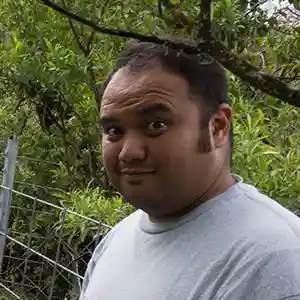
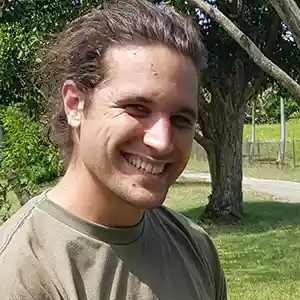
Mario Martinez was a graduate student in the Sustainable Agriculture, Food, and Natural Resources (SAFNR) graduate program at UOG. He worked with the Guam Plant Extinction Prevention Program.
Editor’s note: These authors were beginning graduate students in 2018 taking a course in scientific writing at the University of Guam. This article was assigned to provide the student with practice in communicating science to non-scientists. The student chose the topic which is related either to their thesis project or work experience. The instructor in the course is Dr. Laurie Raymundo, a UOG Marine Laboratory faculty member.
For further reading
Guam Plant Extinction Prevention Program. “Serianthes Nelsonii.” Last modified 10 July 2021.
Raulerson, Lynn, and Agnes F. Rinehart. Trees and Shrubs of the Mariana Islands. Saipan: Commonwealth of the Northern Mariana Islands Coastal Resources Management, 1991.
Stone, Benjamin C. “The Flora of Guam. A Manual for the Identification of the Vascular Plants of the Island.” Micronesica 6, nos. 1-2 (1970): 1-659.
US Fish and Wildlife Service. Recovery Plan for Serianthes nelsonii. By Gary J. Wiles, Ilse H. Schreiner, Donald Nafus, and Rodolpho L. Ando. Portland: FWS, 1994.
US Fish and Wildlife Service Pacific Islands Fish and Wildlife Office. Serianthes nelsonii (Hayun lagu) 5-year Review Summary and Evaluation. Honolulu: PIFWO, 2012.
Wiles, Gary, and E. Williams. “Serianthes nelsonii.” The IUCN Red List of Threatened Species 2017. Last modified 1 September 2016.
Wiles, Gary J., Ilse H. Schreiner, Donald Nafus, Laura K. Jurgensen, and James C. Manglona. “The Status, Biology, and Conservation of Serianthes nelsonii (Fabaceae), an Endangered Micronesian Tree.” Biological Conservation 76, no. 3 (1996): 229-239.

